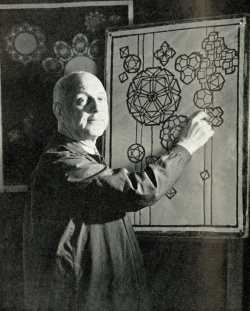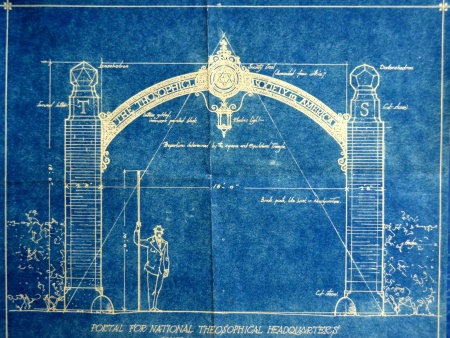Claude Fayette Bragdon
ARTICLE UNDER CONSTRUCTION
ARTICLE UNDER CONSTRUCTION
Claude Fayette Bragdon was an American architect, artist, writer, and publisher who was active in the Theosophical Society in America. He operated the Manas Press in Rochester, New York, and was the first publisher of P. D. Ouspensky's work, Tertium Organum. Dr. James Cousins referred to him as "Claude Bragdon of America to whom Architecture is Theosophy in stone."[1]
Early life and education
Architectural work
Design work
Early in his career, Bragdon designed bindings for books like these:
- At the Sign of the Sphinx: A Book of Charades by Carolyn Wells, New York: Stone and Kimball, 1896.[2]
- Stories from the Chap-book; Being a Miscellany of Curious and Interesting Tales, Histories, &c, a compilation by many authors. Chicago: Herbert S. Stone and Company, 1896. [3]
After giving up his architectural practice, Bragdon went to New York City, where he designed sets for Broadway plays.
Theosophical Society work
Influence on Olcott headquarters campus
In 1926, when the American Theosophical Society was planning its new national center in Wheaton, Illinois, Bragdon was asked to serve as architect. He was then reorienting his career from architecture to stage design, so he declined. He recommended engaging Pond, Pond, Martin & Lloyd, the Chicago architectural firm headed by his friend Irving Kane Pond, and the Society followed his advice. The architects submitted two designs for consideration, and the Society's Board of Directors was evenly divided over which should be the finalist. President L. W. Rogers sent both drawings to Bragdon, who sent back a telegram saying that his preference would be the "asymmetrical" design, and that is the one that was built.
Bragdon did design an important structure at the headquarters campus that was unveiled for members in a Co-Masonic dedication ceremony at the summer convention in 1940. An arch was built at the Main Street entrance to the campus. The cost of the project was underwritten anonymously by a member from Portland, Oregon, later acknowledged to be John H. Mason. Two stone and brick support columns are topped by carved Platonic solids – a dodecahedron and an icosahedron. Between them is a wrought iron arch with the name of the Theosophical Society in America and the TS emblem in the center. Originally a lighted lantern hung from the emblem, but it had to be removed in later years when vehicles became taller.
In 1942, then-President Sidney A. Cook wrote:
As I look out my office window a car stops at our gateway, as cars often do, while its occupants read the bronze plaques on its pillars, moving from the one to the other to read the whole of the statements they contain as to the founding, the Founders and the principles. The car passes on, but our Headquarters has made its impression; the breadth and dignity of our principles have sown seed. [4]
In 1989, the entire gateway had to be moved a few feet to accommodate a turn lane in Main Street, when an apartment complex was built across the street.
Writings
Bragdon frequently wrote articles for Theosophical magazines. The Union Index of Theosophical Periodicals lists over 90 titles by or about Bragdon. He also wrote excellent books about architecture, art, and Theosophy:
- The Arch Lectures.
- Architecture and Democracy. 1918. Available at Internet Archive.
- The Beautiful Necessity: Seven Essays on Theosophy and Architecture. 1910. Rochester, NY: Manas Press. 109 p. Available at Internet Archive, Internet Archive, Hathitrust, Google Books, and Google Books.
- Episodes from an Unwritten History. Rochester, NY: Manas Press. In 1910, an enlarged second edition was published. Available atInternet Archive.
- The Eternal Poles.
- Four Dimensional Vistas. 1916. New York: Alfred A. Knopf. Available at Internet Archive and Internet Archive.
- The Frozen Fountain.
- The Golden Person of the Heart.
- Man the Square: a Higher Space Parable. 1912. 34p.
- "The Master of the Blue Cape" [story]. This inspired two members of the St. Petersburg Lodge to stage an impromptu play on December 21, 1938.[5]
- Merely Players.
- More Lives Than One.
- The New Image.
- Old Lamps for New, or The Ancient Wisdom in the Modern World.
- Oracle. 1921. Rochester, NY: Manas Press. 64 p. Portrait in frontispiece. Available at Internet Archive. Bragdon collected messages that had been received by his deceased wife Eugenie Julier Macaulay Bragdon via automatic writing. Some are epigrammatic personal messages, and others are prophetic.
- A Primer of Higher Space (the Fourth Dimension). 1913. Rochester, NY: Manas Press. 78 p. Illustrated. Available at Internet Archive.
- Projective Ornament. 1915. Rochester NY: Manas Press. 78 p. Illustrated.
- Self Education: An Address Given Before the Boston Architectural Club April the third 1909. 1910. Rochester, NY: Manas Press. 16 p. Available at Internet Archive.
- Six Lectures on Architecture. 1917. Chicago: University of Chicago Press. Scammon Lectures. Coauthors were Ralph Adams Cram and Thomas Hastings. Available at Internet Archive.
- The Small Old Path. 1914. Rochester, NY: Manas Press. 2nd edition. available at Internet Archive, Internet Archive, Internet Archive, and Internet Archive.
- Theosophy and the Theosophical Society. 1909. Rochester, NY: Manas Press.
- Yoga for You.
Additional resources
Notes
- ↑ James H. Cousins, "The Life and Work of Jean Delville, Theosophist Painter-Poet." The Theosophist47.3 (December 1925), 396.
- ↑ See title page of book at Internet Archive.
- ↑ See title page of book at Internet Archive. Internet Archive, and Internet Archive.
- ↑ S.A.C.[Sidney A. Cook], "Our Gateway," The American Theosophist 30.3 (March, 1942), 70.
- ↑ Bulletin of the Florida Federation. January 15, 1939. From clipping in National Secretary's files for St. Petersburg Lodge.

